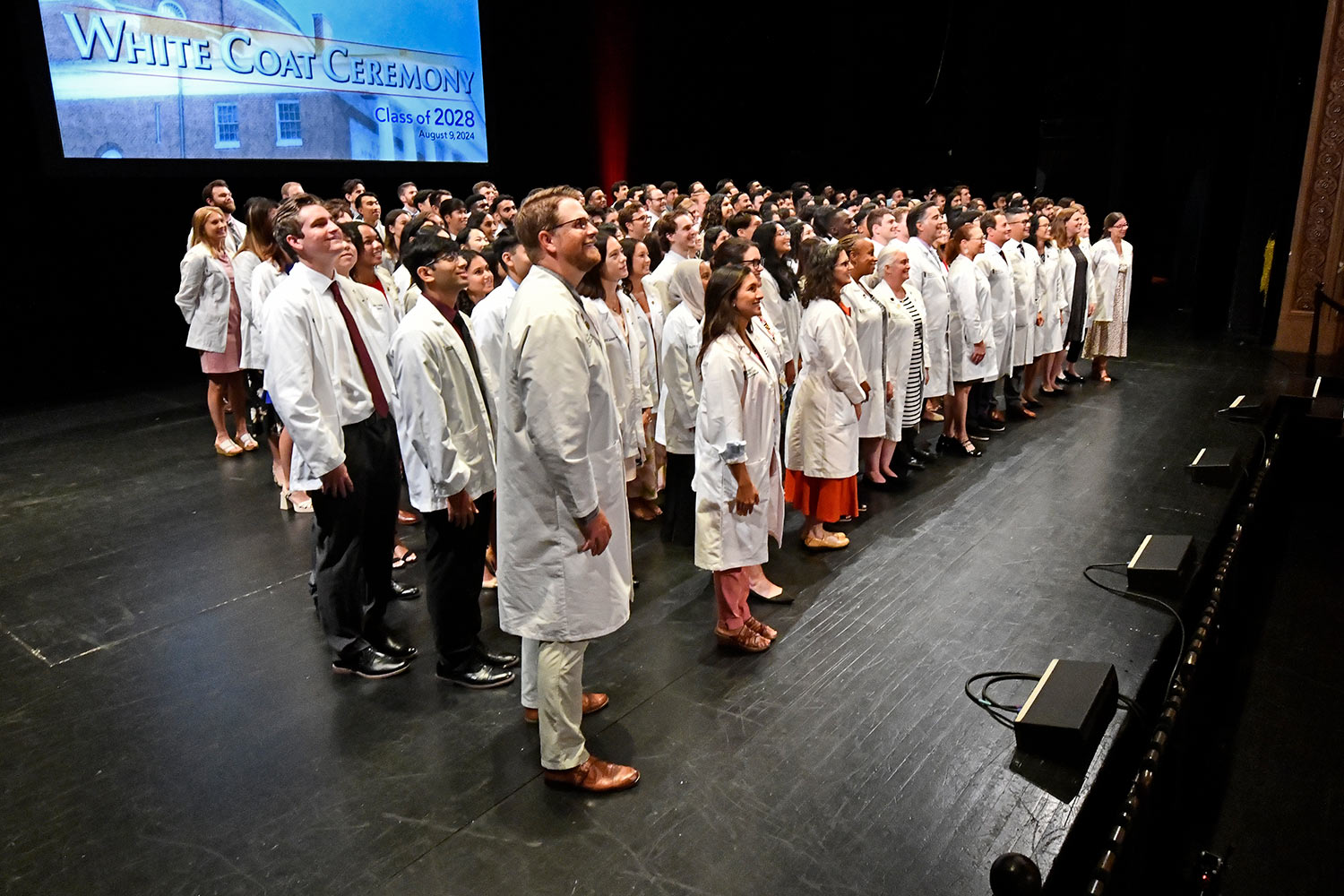August 29, 2024 | Holly Moody-Porter
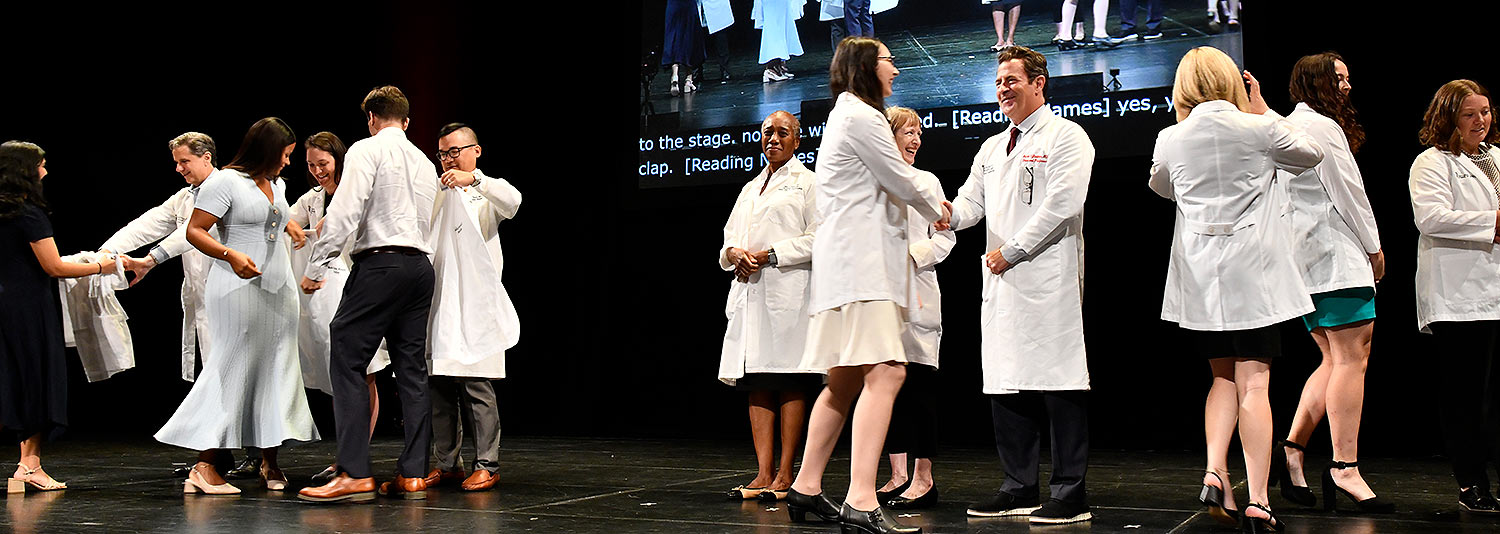
The University of Maryland School of Medicine (UMSOM) welcomed 165 new students making their first entrance into the practice of medicine through the tradition of the White Coat Ceremony. The ceremony took place on August 9 with family, friends, faculty, and staff gathering at the historic Hippodrome Theatre to celebrate the Class of 2028 as students received the first white coat of their careers.
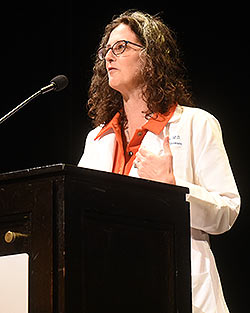 Established in 1997, the annual ceremony honors the white coat as a traditional symbol of the medical clinician and scientist, representing the knowledge, skill, and integrity of the medical professionals who wear it, along with the highest standards of professional work, whether in the classroom, laboratory, or clinic.
Established in 1997, the annual ceremony honors the white coat as a traditional symbol of the medical clinician and scientist, representing the knowledge, skill, and integrity of the medical professionals who wear it, along with the highest standards of professional work, whether in the classroom, laboratory, or clinic.
Throughout the event, the incoming students and their families heard words of encouragement and reflections on the symbolism of the white coat from UMSOM faculty, staff and current students. The speakers also praised the new students for their commitment and diligence that earned them entrance into a highly-regarded medical school.
“Today’s ceremony is a time of celebration in which we recognize the hard work and accomplishments that have led to this moment for students,” said Kerri Thom, MD, MS, Professor of Epidemiology & Public Health and Associate Dean for Student Affairs, in her opening remarks. “As students navigate the next four years, we hope that they do so knowing that they are not taking this journey alone. Their peers, faculty, staff, family and friends, are all along for the ride.”
During UMSOM Dean Mark Gladwin’s compelling address, he emphasized the importance of shared decision-making in medicine and reminded students to embrace boldness throughout their careers.
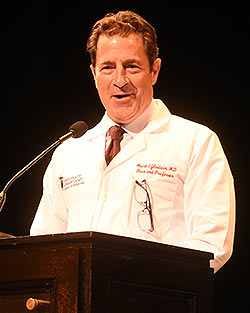 “To sit in this room, you all have boldly embraced uncertainty, a life of change, stress, discipline, and a commitment to a deep understanding of science and humanism,” said Dean Gladwin, who is also the John Z. and Akiko K. Bowers Distinguished Professor and Dean and Vice President for Medical Affairs at University of Maryland, Baltimore. “And above all, I think you all have embraced your own vulnerability by committing yourself to a career that demands lifelong learning, constant self-reflection, and external tough feedback. These attributes allow you to always evolve and improve as a physician and a healer.”
“To sit in this room, you all have boldly embraced uncertainty, a life of change, stress, discipline, and a commitment to a deep understanding of science and humanism,” said Dean Gladwin, who is also the John Z. and Akiko K. Bowers Distinguished Professor and Dean and Vice President for Medical Affairs at University of Maryland, Baltimore. “And above all, I think you all have embraced your own vulnerability by committing yourself to a career that demands lifelong learning, constant self-reflection, and external tough feedback. These attributes allow you to always evolve and improve as a physician and a healer.”
Following Dean Gladwin’s address and remarks from student and faculty speakers, each student was called up to the stage and donned with a short white coat by UMSOM faculty, some of whom were also parents of the students. They also signed the Honor Registry, a permanent record of their commitment to the school’s great history and honor, which is displayed in UMSOM’s historic Davidge Hall. Students also received a stethoscope, provided through contributions of alumni of The Medical Alumni Association, and a note written to each of them by an UMSOM alumnus.
 After receiving their coats, students recited the Code of Honor, representing the public acknowledgment of the responsibilities of the medical profession, and their willingness to assume such obligations. Alongside the English recitation, several students each recited a portion of the oath on stage in their native language, celebrating the diversity of the class.
After receiving their coats, students recited the Code of Honor, representing the public acknowledgment of the responsibilities of the medical profession, and their willingness to assume such obligations. Alongside the English recitation, several students each recited a portion of the oath on stage in their native language, celebrating the diversity of the class.
The UMSOM Class of 2028 represents 71 percent in-state and 29 percent out-of-state students, representing 61 different colleges and universities. The class is composed of 57 percent women, 67 percent students of color, and 20 percent who identify as LGBTQ+. Several student interviewees shared why they chose medicine and the impact they hope to have in their patients’ lives.
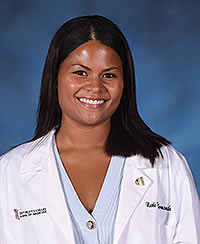 For first-year student Lauryn Brooks, her passion for medicine was instilled when supporting her mother through a chronic illness. “I really saw how patient-physician interactions motivated her and helped her through her process,” said Brooks. “That is something that I want to do for other people now that I am in medical school.”
For first-year student Lauryn Brooks, her passion for medicine was instilled when supporting her mother through a chronic illness. “I really saw how patient-physician interactions motivated her and helped her through her process,” said Brooks. “That is something that I want to do for other people now that I am in medical school.”
As an immigrant who came to Baltimore from Venezuela, Nicole Fortune Hernandez shared the influence of her family’s experience with healthcare soon after arriving in the U.S. “I was inspired by my pediatrician who just so happened to be from Venezuela,” she said. “She was able to speak with us in our native language while we were trying to learn English and she always made us feel very comfortable. I recognize that we need more people in spaces to be representative of the population that we serve.”
Watch the Video
 Andrew Ayers credits his university education for inspiring him to become a physician. “In college, I became interested in environmental health and how the spaces that we inhabit, that we live, work, and play in, impact our health,” he said. “This is something that attracted me to medicine in my undergraduate education and one of the main reasons why I am here today.”
Andrew Ayers credits his university education for inspiring him to become a physician. “In college, I became interested in environmental health and how the spaces that we inhabit, that we live, work, and play in, impact our health,” he said. “This is something that attracted me to medicine in my undergraduate education and one of the main reasons why I am here today.”
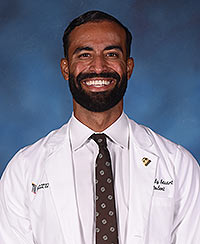 For Freddy Stuart, his military background fueled his aspirations to enter the field. “Growing up in a military family, the values that were instilled in me were that of duty, honor and a commitment to something that was greater than yourself,” he said. “I followed my father into the military and wanted to have a more impactful mission for my community. I think a great continuation of that mission is in medicine, where I can have patient-physician interaction on a very individualistic scale.”
For Freddy Stuart, his military background fueled his aspirations to enter the field. “Growing up in a military family, the values that were instilled in me were that of duty, honor and a commitment to something that was greater than yourself,” he said. “I followed my father into the military and wanted to have a more impactful mission for my community. I think a great continuation of that mission is in medicine, where I can have patient-physician interaction on a very individualistic scale.”
The presenting sponsor for this year’s celebration was Whiting-Turner. The event was also supported by contributions from the Medical Family Annual Fund.
View the Photo Gallery >
About the University of Maryland School of Medicine
Now in its third century, the University of Maryland School of Medicine was chartered in 1807 as the first public medical school in the United States. It continues today as one of the fastest growing, top-tier biomedical research enterprises in the world -- with 46 academic departments, centers, institutes, and programs, and a faculty of more than 3,000 physicians, scientists, and allied health professionals, including members of the National Academy of Medicine and the National Academy of Sciences, and a distinguished two-time winner of the Albert E. Lasker Award in Medical Research. With an operating budget of more than $1.2 billion, the School of Medicine works closely in partnership with the University of Maryland Medical Center and Medical System to provide research-intensive, academic, and clinically based care for nearly 2 million patients each year. The School of Medicine has more than $500 million in extramural funding, with most of its academic departments highly ranked among all medical schools in the nation in research funding. As one of the seven professional schools that make up the University of Maryland, Baltimore campus, the School of Medicine has a total population of nearly 9,000 faculty and staff, including 2,500 students, trainees, residents, and fellows. The School of Medicine, which ranks as the 8th highest among public medical schools in research productivity (according to the Association of American Medical Colleges profile) is an innovator in translational medicine, with 606 active patents and 52 start-up companies. In the latest U.S. News & World Report ranking of the Best Medical Schools, published in 2023, the UM School of Medicine is ranked #10 among the 92 public medical schools in the U.S., and in the top 16 percent (#32) of all 192 public and private U.S. medical schools. The School of Medicine works locally, nationally, and globally, with research and treatment facilities in 36 countries around the world. Visit: medschool.umaryland.edu
Contact
Holly Moody-Porter
Sr. Media & Public Relations Specialist
hmoody@som.umaryland.edu
Related stories
Tuesday, December 19, 2023
UM School of Medicine Recognizes Student Research Excellence and Outstanding Faculty Mentors at 46th Annual Medical Student Research Day
A proud tradition for the University of Maryland School of Medicine (UMSOM) community, the annual Medical Student Research Day (MSRD) showcases the research accomplishments of medical students who participate in research projects throughout the year. This year’s event, held November 28 and November 29 at the SMC Campus Center, was proudly sponsored by the Alpha Omega Alpha (AOA) Honor Society and the Office of Student Research (OSR) in the Dean’s Office. The largest event to date in the history of MSRD at UMSOM, this year’s event featured 114 student presenters (study years 2-4, MS2-MS4) and 125 presentations.

